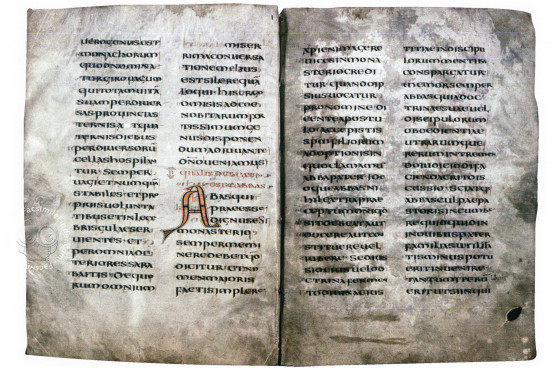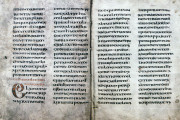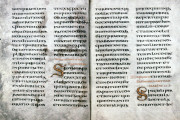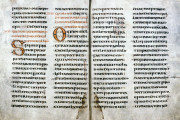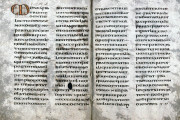Also known as the Oxoniensis (O) edition, MS Hatton 48 is the oldest existing copy of the Rule of St Benedict, a code of conduct for monastic life written in 516. Dating to the early eighth century, it is written in a stately Insular Uncial script with an archaism perhaps meant to add gravitas to the work. Its exact origin in the south or midlands of England is unknown, but it was certainly a monastic scriptorium with a talented Insular scribe who preferred Roman over Irish letterforms. The high quality of its overall workmanship suggests an important patron, however, the low quality of the parchment indicates a limitation in resources.
It is one of only fourteen surviving Insular Uncial manuscripts and is an especially fine example. The Rule is written scriptio continua, or without spaces, in two columns of twenty-two lines making it an ostentatious manuscript in its large lettering and textual decoration. Despite this, it was little used and never copied. The first sixteen leaves have evidence of thirteenth-century repairs and augmentations and it was studied academically in the seventeenth century. It stands as a glorious example of Early English manuscript production and the dissemination and importance of the Benedictine code within their monasteries.
Ribbon-like Rubricated Initials
The decoration of this manuscript is entirely textual and without illustrative illumination. Each major section is demarcated with an initial enlarged over three, or sometimes four, lines. They are calligraphic and ribbon-like outlined in black, filled with red, and decorated with double bars similar to the decorated lettering in the Saint Petersburg Bede (St Petersburg, Nat. Lib. of Russia, Lat. Q.v.I.18). There are seventy-seven major initials in all. Verse initials are slightly enlarged, denoted with a rubricated verse number, and dotted around their perimeters in red.
Rare Insular Uncial Manuscript
Documents written entirely in Insular Uncial are rare with only three charters and fourteen manuscripts surviving from the late seventh through early eighth centuries. The script was replaced by half-uncial and minuscule as book production increased. This is an especially nice example of the script evident in the variety seen in the S and N enlarged initials where the swirls and cross-bars become the main focus of the artistic expression. This lends the work a subtle charm and engagement but it may also have had a more practical function to act as visual bookmarks.
Some Damage but Little Used
Despite portions of the parchment having been cut from fols. 48 and 49, some minor water damage and the missing final pages, overall the Oxoniensis Rule of St Benedict is in remarkably good condition for a book 1,300 years old. The text is generally clear and highly legible and the rubricated initials are bright and sharp. Although its origins are uncertain, perhaps Canterbury or Worcester, it was kept in Worcester from ca. 1050 to 1623 and likely little-used. It was purchased by Oxford from Robert Scot in 1671.
Binding description
The worn binding is medieval oak boards covered in white leather. The pattern of tongs and whittawed skins consistent with a pre-1100 date. Localized to Worcester based on matched scrap binding material matching to two other Worcester manuscripts (Oxford, Bodleian Library, Lat. Theo. D 33 and Oxford, St John's College Librarly, Ss.7.2). Spine repair is post-1600.
We have 1 facsimile edition of the manuscript "Oxford Rule of Benedict": The Rule of St. Benedict facsimile edition, published by Rosenkilde and Bagger, 1968
Request Info / Price
